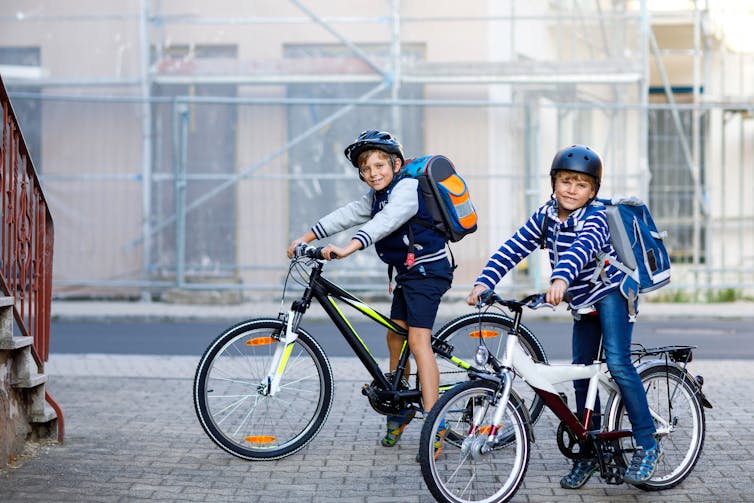Stanley Windsor, Loughborough University
When parents in the UK were suddenly forced to become teachers to their kids in lockdown, physical education (PE) was largely an afterthought. As many PE lessons are now delivered by outside professional coaches, few primary schools had the in-house experience or skills to create and suggest content to help parents.
Instead, many turned to fitness guru Joe Wicks. His PE with Joe, a 30-minute live workout streamed on YouTube every weekday at 9am, was launched almost immediately following the closure of schools across the UK.
The videos are based on Wicks’ brand of high-intensity interval training (HIIT) — intense, repetitive exercises with short breaks — but are aimed at children. Exercises included star jumps and “Pikachus”, and on Fridays Wicks and his audience worked out in fancy dress.
Wicks is to be applauded for getting more children and their parents thinking about and taking part in exercise, showing them it can fit into their daily lives. But what will happen as lockdown comes to an end?
A different kind of PE
Throughout lockdown, exercise has been lauded as both a coping mechanism through the restrictions and an effective support for the immune system. As parents’ willingness to engage in PE has increased, so has the involvement of children, which in turn has created a ritualised, family-centred engagement with exercise.
The Joe Wicks movement has also led to the realisation that PE does not necessarily mean sport. For years, PE within primary education has been commonly associated with sport and sport-specific games. The use of professional coaches, often provided by professional sports teams, has added to the assumption that this is the only way to deliver PE as a subject.
Instead, Wicks offers a vision of a novel and inclusive curriculum based around fitness and not sport that might hold the answer to a more active nation.
Staying active
The World Health Organization recommends that children and young people aged five to 17 should take part in at least 60 minutes of moderate-to-vigorous physical activity daily. The UK government’s current assumption is that at least 30 minutes of this is completed outside of school time.
As lockdown eases, routines will revert to normal. Children may be at school at 9am rather than following a workout video. So it’s important that these new habits are not lost.
Here are five ways to make sure a post-lockdown routine helps children build upon the their Joe Wicks PE lessons.
1. Active travel
Car-free streets as a result of travel restrictions has resulted in a wave of first time bikers, joggers and skaters. We are now allowed back in our cars, but this doesn’t mean we have to drive. A walk or cycle to school not only gets the required physical activity in, but could also boost your child’s academic performance.
2. Focus on ‘physical literacy’
Joe Wicks wasn’t the first to dream up the idea that non-sport based education would be beneficial. Children’s exercise initiative BOING at home has created a free online resource pack around the concept of “physical literacy”.

Romrodphoto/Shutterstock
Physical literacy focuses on holistic physical development and how a child moves and interacts with the space and environment around them. In a world consumed by measuring success, advocates of physical literacy prefer to chart progress instead, and suggest that the level at which people are physically literate can change based on their environment. Being physically literate has also been linked with academic success.
3. Be a role model
One of the great successes of Joe Wicks’ PE with Joe was the family involvement, support and encouragement it required. There is a wealth of research that suggests improving the physical activity level of parents is a significant contributor to the overall health of their children.
4. Keep exercising at home
Online streaming has boomed in lockdown and the greater adoption of digital entertainment is expected to be a widespread trend. Now that Joe Wicks is winding down his efforts, parents might look to others to fill the void. The BBC and the Learning Station both offer age-appropriate resources for getting children active at home.
5. Take part in community activity
Local community run clubs for activities such as orienteering, rock climbing, rambling and adventure groups like the Scouts all support a physically active lifestyle without sport as a focus. Importantly, these are also a great way to support the social development of young people.
The UK government has recognised that sport is only part of the picture in terms of getting more people active, as noted in a 2015 consultation paper on sport strategy.
We have an opportunity here to establish physical activity as an ongoing habit. As Wicks scales back his PE sessions, the focus now turns to how parents, communities and teachers can learn from this experience and keep PE and physical activity relevant and successful.![]()
Stanley Windsor, PhD Candidate, Institute for Sport Business, Loughborough University
This article is republished from The Conversation under a Creative Commons license.


